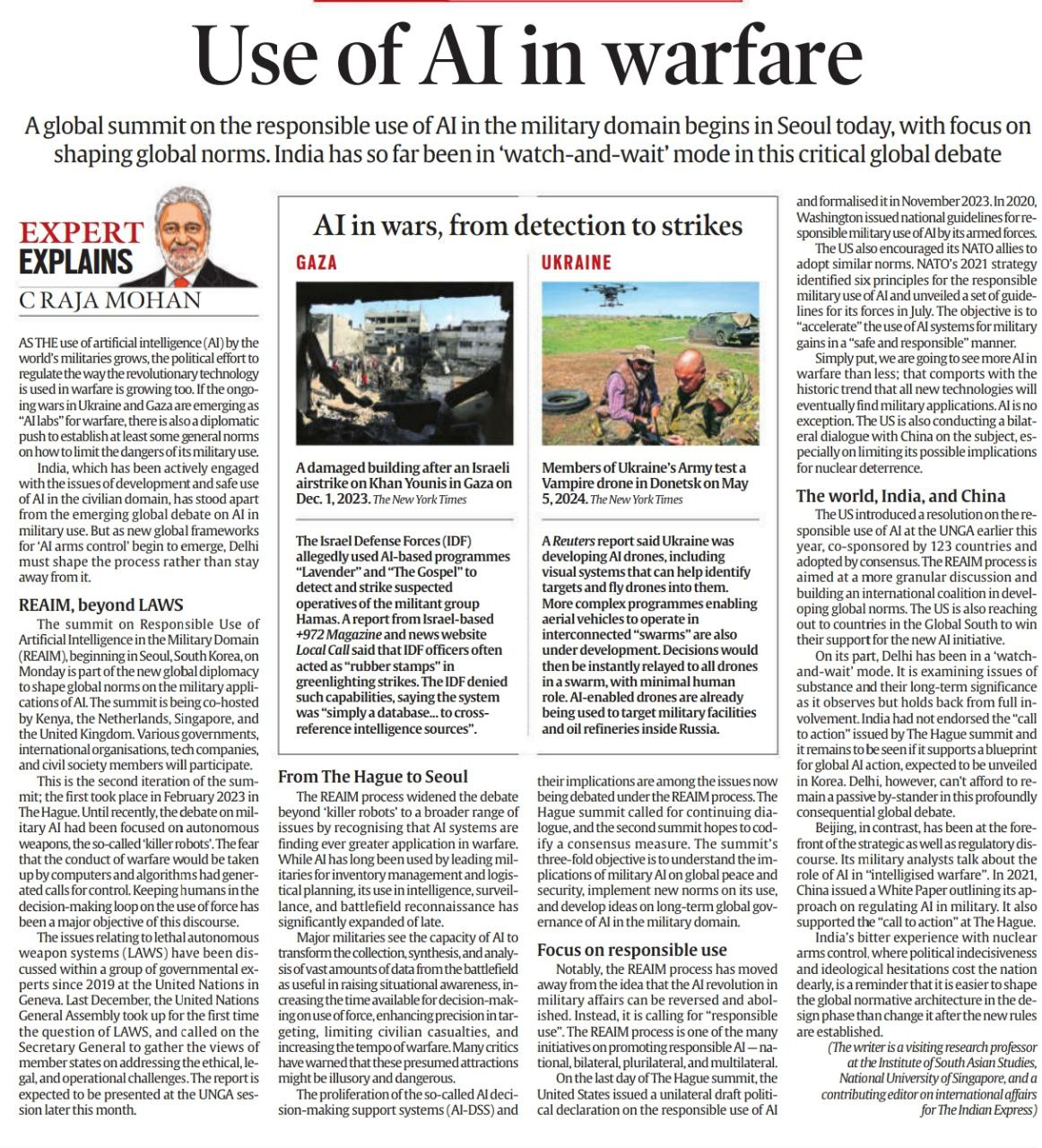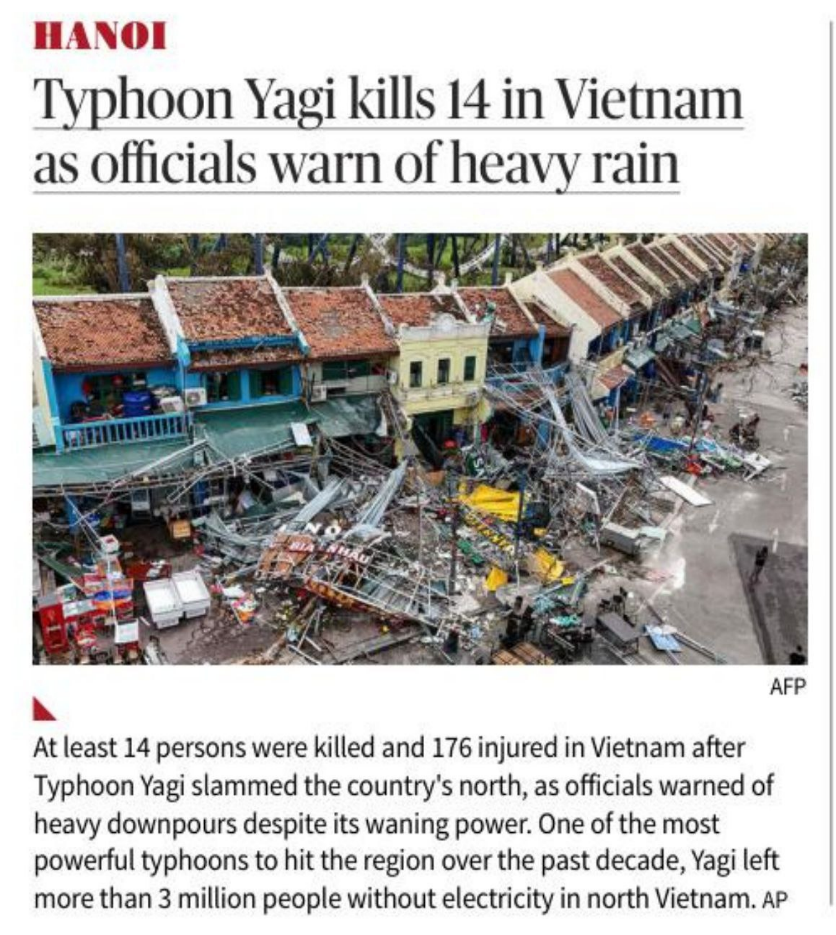Index:
- Five Sutras for Digital Infrastructure
- Use of AI in Warfare
- India's Military Diplomacy: Back-to-Back Exercises
- India, U.S. Agree to Swap Turns: Biden to Host Quad Summit
- Periodic Reset: India-ASEAN Engagement
- Challenge to Rural Chinese Tradition on Women’s Village Membership
- News in Short
- Uncommon Cyclones in the Arabian Sea
- Arctic ice melting and its Impact
1. Five Sutras for Digital Infrastructure
Context: India’s success: Over 80% financial inclusion achieved within six years.
- Highlighted at the 2023 G20 summit, focusing on Digital Public Infrastructure (DPI).
- Importance of DPIs:
- Enabling digital sovereignty, financial inclusion, and self-reliance.
- Global recognition of India’s role in shaping the digital landscape, especially in the Global South.
- Challenges:
- Various stakeholders (enterprises, organizations, governments) must ensure security, scalability, and inclusivity in DPI.
- Digital platforms need to handle complex user privacy and data protection issues.
- Citizen Stack:
- A trusted ecosystem aligned with India Stack, providing a dependable infrastructure.
- Offers secure, reliable, scalable, and privacy-protecting
- Ensures that DPIs meet stringent security and integrity standards while being inclusive.
- Five Sutras (Guidelines for Good DPIs):
- Authenticity and Integrity: Ensuring transparent and authentic DPIs to prevent exploitation.
- Security: Focus on protecting user privacy with strong encryption and cybersecurity practices.
- Inclusivity: Accessible to all, ensuring digital infrastructure reaches marginalized populations.
- Collaboration: Encourage multi-stakeholder partnerships to enhance scalability and transparency.
Sustainability: Ensure future-proof infrastructure that adapts to evolving technology.
2. Use of AI in Warfare
Context: A global summit on the responsible use of Artificial Intelligence (AI) in the military domain (REALM) is being held in Seoul. Focus is on shaping global norms for the use of AI in warfare.
- AI in Modern Warfare:
- Gaza: Israeli Defense Forces (IDF) allegedly used AI-based programs like “Lavender” and “The Gospel” to detect and strike targets in Gaza.
- Ukraine: Ukraine’s Army uses AI-powered drones like the Vampire to identify and target Russian military assets.
- Challenges of AI in Warfare:
- Lethal Autonomous Weapon Systems (LAWS): The growing debate around autonomous systems taking over human decision-making in warfare.
- Ethical Concerns: There are concerns regarding AI’s ability to make decisions related to lethal force, increasing the risks of unintended consequences.
- Global Efforts: The UN and other international bodies are pushing for guidelines and treaties to ensure the responsible use of AI.
- From Hague to Seoul:
- The REALM process initiated in The Hague (February 2023) focused on preventing “killer robots” and emphasized the need to distinguish between AI in civilian and military applications.
- The Seoul summit aims to broaden the conversation to ensure global cooperation on the responsible development and deployment of AI in warfare.
- India’s Position:
- India has been actively engaging in the development of AI for civilian use but has so far taken a “watch-and-wait” stance on the military use of AI.
- India’s participation in the ongoing debate is crucial for shaping future policies and strategies on AI in warfare.
- Global Response:
- The US and NATO have introduced guidelines for responsible AI use in their armed forces.
- The summit emphasizes multilateral cooperation, with countries like the US, China, and others working on ensuring AI use is safe, secure, and ethical in military operations.
- Focus on Responsible Use:
- The need to ensure AI remains under human control, and the prevention of its use in ways that escalate conflicts or cause unintended harm.
Efforts are being made to draft international declarations on the responsible use of AI, especially focusing on military systems and nuclear deterrence.
3. India's Military Diplomacy: Back-to-Back Exercises
Context: India has been engaging in several military exercises with countries across the globe involving all three services (Army, Navy, Air Force).
- Key Exercises:
- Yudh Abhyas: A bilateral Army exercise between India and the US, set to commence at the Mahajan field firing ranges in Rajasthan.
- Tarang Shakti: The largest multilateral Air Force exercise, Phase-II is underway at Jodhpur, involving 8 countries and 17 observer nations. Key participants include Australia, Greece, Japan, and Sri Lanka.
- Malabar Exercise: A naval exercise involving India, Australia, Japan, and the US at the Visakhapatnam coast.
- Significant Military Engagements:
- US-India Partnership:
- This year’s Yudh Abhyas features the largest US contingent with around 600 US personnel.
- Deployment of Stryker infantry vehicles and M142 HIMARS (High Mobility Artillery Rocket System).
- India and the US are in talks for the licence manufacture of vehicles, including the Javelin anti-tank guided missiles (ATGMs).
- Mitra Shakti: A bilateral Army exercise between India and Sri Lanka, conducted from August 12-25 at the Combat Training School in Sri Lanka.
- US-India Partnership:
- Global Participation:
- Aircraft and jets from Australia, Greece, Japan, Singapore, Sri Lanka, UAE, and others have participated in these exercises.
India’s Air Force has been engaging in these exercises with F-16s from the US and various other aircraft
4. India, U.S. Agree to Swap Turns: Biden to Host Quad Summit
- Context:
- India and the U.S. have agreed to swap hosting turns for the upcoming Quad Summit.
- S. President Joe Biden will host the 2024 Quad Summit in his home state, Delaware.
- Key Points:
- Originally, India was to host the Quad Summit alongside the UN General Assembly in New York, but the U.S. took over hosting responsibilities for 2024.
- India will now host the 2025 Quad Summit.
- The Quad members include India, the U.S., Australia, and Japan, with a focus on promoting regional security and cooperation in the Indo-Pacific region.
- Schedule:
- The summit will be held on September 21, 2024.
- PM Narendra Modi will also address the diaspora in the U.S. on September 22, followed by his address to the UN General Assembly on September 26.
External Affairs Minister S. Jaishankar will participate in the General Debate on September 28.
5. Periodic Reset: India-ASEAN Engagement
- Context:
- PM Narendra Modi’s visit to Brunei and Singapore signifies a renewed focus on India’s Act East Policy in the government’s third term.
- This is the first bilateral visit by any Indian PM to Brunei, highlighting the strategic importance of the region.
- Trade and Strategic Ties:
- While India’s trade with ASEAN has doubled over the past decade, trade with Brunei has declined.
- Brunei has ramped up oil imports from Russia since 2022.
- Discussions revolved around space cooperation (including the possibility of an ISRO station in Brunei), defense, and geo-strategic issues with a veiled critique of China’s influence in the region.
- India-Singapore Ties:
- Modi’s visit to Singapore emphasized semiconductors, critical due to Singapore’s role in the global electronics supply chain.
- India, with its expertise in rare earths and semiconductor production, could collaborate with Singapore to reduce labor costs and navigate global tensions, such as S.-China-Taiwan relations and Chinese predatory practices.
- Challenges:
- India’s exit from RCEP (Regional Comprehensive Economic Partnership) in 2019 limited its participation in a significant regional trade agreement.
- Despite ASEAN’s encouragement to reconsider, India has stuck to its decision.
- To boost trade, India must focus on agreements like ATIGA (2009) and CECA with Singapore (2005).
- Strategic Importance:
- India’s engagement with ASEAN remains key, especially with regard to Indo-Pacific strategy, security issues (such as the South China Sea), and Quad
- ASEAN remains central to India’s regional policy, but it requires a more consistent and coordinated effort to align geopolitical strategies.
- Conclusion:
- India’s Look East Policy (1992) and Act East Policy (2014) need a periodic reset to adapt to current geopolitical realities, as ASEAN is vital for India’s long-term strategic and economic interests in the Indo-Pacific.
6. Challenge to Rural Chinese Tradition on Women’s Village Membership
- Context:
- In rural China, women often lose their village membership and access to payouts when they marry, due to longstanding male-dominated traditions.
- Village councils (male-dominated) have denied women benefits like health insurance, land rights, and pension payouts, traditionally allocated to village members.
- Tradition of Exclusion:
- Women are treated as appendages to men, first belonging to their fathers before marriage and to their husbands after marriage.
- After marriage, a woman is no longer considered a member of her native village, and she is not fully accepted in her husband’s village either, leaving her without village rights.
- Sisterhood Movements:
- Women from different villages are coming together to challenge these patriarchal traditions through lawsuits and civil society action.
- These sisterhoods are fighting for equal access to village membership, land rights, and the benefits traditionally denied to married women.
- Legal Battle:
- Most legal battles have favored the women, but village councils often refuse to recognize court rulings.
- The issue has been exacerbated by China’s economic liberalization, which has placed greater emphasis on land and resource distribution.
- State Response:
In June, the Chinese government passed a law reaffirming that village assemblies should decide on equal land distribution and payouts, but many village councils continue to resist these changes.
8. Uncommon Cyclones in the Arabian Sea
- Context:
- The North Indian Ocean (which includes the Arabian Sea and Bay of Bengal) experiences two cyclone seasons: pre-monsoon and post-monsoon, unlike other global cyclone regions that only experience one season.
- Unique Features of the Indian Ocean:
- The monsoonal circulation plays a key role, with reversals in wind direction between pre-monsoon and post-monsoon phases.
- The Indian Ocean is impacted by both the Pacific and Southern Oceans, with the Pacific Ocean warming up rapidly, and the Southern Ocean pushing cooler waters.
- The Arabian Sea sees rapid warming during the pre-monsoon season, adding more moisture to the atmosphere.
- Cyclone Asna:
- Named Asna, it was a rare August cyclone in the Arabian Sea, the first of its kind since 1981.
- Formed from a strong low-pressure system over the Arabian Sea in August 2024.
- Low-pressure systems in the Arabian Sea usually form in the Bay of Bengal but bring moisture and rainfall to India.
- Climate Change’s Impact:
- Rising sea surface temperatures (SSTs) due to global warming are contributing to increased moisture in the atmosphere.
- This causes stronger cyclonic activity in the Arabian Sea, leading to unusual cyclones like Asna.
- The monsoonal reversal is expected to become more unpredictable with climate change, affecting cyclone patterns further.
- Are two cyclone seasons common?:
- The North Indian Ocean is the only region in the world where cyclogenesis (cyclone formation) happens in both pre-monsoon and post-monsoon
- All other cyclone basins have just one season. This division is a result of complex factors like the monsoonal winds, sea temperatures, and atmospheric conditions.






